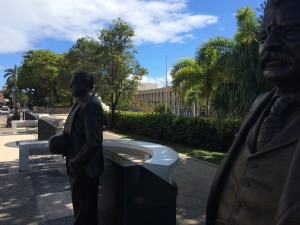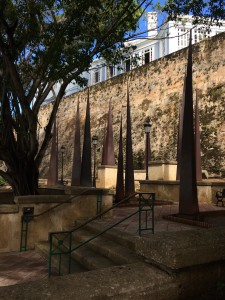A little time in Puerto Rico made for a good break from the cold northeast weather. Old San Juan, with its castillos and extensive muro is an evocative look into the past filled with colonial history. You can imagine yourself transported back to a time when Europe and the Americas were as unstable and treacherous as some of today’s third-world countries. The streets of Old San Juan are charming, cramped, and colorful, but they’d be more spectacular if only automobiles were banned, entirely, with only a quiet electric powered shuttle looping around the peninsula. Took a hike in scenic El Yunque National Forest, and of course, relaxing walks on the beach.
A visit to the Museo de Arte Contemporáneo de Puerto Rico, and the Museo de Arte de Puerto Rico, both exclusively featuring art by the island’s nationals, finished off the week on a cultural note. The Museo de Arte has a comprehensive collection of both old, modern, and contemporary art housed in an attractive neoclassical building with nicely groomed grounds and sculpture garden. It’s well worth a visit. And I suspect, by our reception, never crowded. The Museo de Arte Contemporáneo is housed in an old high school featuring a large, glass-covered atrium and three floors of large classroom-size galleries. Like other exclusively contemporary art museums, it’s, well, uhm, pretty much, uh—it makes me wonder.
But on the way to the Contemporáneo, we passed the Centro de Bellas Artes, the primary performing arts center of San Juan, located in the struggling to be up and coming Santurce area. Outside its two building campus, connecting the main building with the Sala Sinfonica, is a large plaza with a long fountain and nine life-size bronzes, titled The Muses. Each depicts one of the arts, tragedy, comedy, dance, drawing/painting, architecture, literature/poetry, sculpture, cinema, and music. It’s a wonderful example of well placed public art, which San Juan is particularly bestowed. Those muses, and the contrasting experience at the contemporary arts museum, and the rise of “performance art,” as opposed to the performing arts, got me thinking.

Paseo de los Presidentes—Nine presidents have visited Puerto Rico, each memorialized in bronze across from the Capitolio,
What is performance art? How does it differ from the performing arts? Why am I incensed by it? Why do I find it, and most contemporary art, shallow, trivial, and offensive. Note that it’s not offensive to me because some may see it as obscene or deliberately inciting outrage, no, rather, because other than being curious, it’s completely arid.
I question how a boring video, simplistic, clumsy and fuzzy, can get labeled “important” and shown in a supposedly world class museum? I question how a narcissist doing any sort of you-name-it mundane act in front of patrons or passersby can be seen as remotely socially productive? I question how work that is ostensibly aimed at opening minds to significant sociopolitical issues displayed in the sterile, hermetic chambers of an art museum could indeed effect change?
Think for a moment about the performing arts. Think about the time, the training, the practice it takes to develop one’s talent. This applies equally to all the arts. Skill, talent, training, practice are, or were in the past, the prerequisites to producing art, and how art is/was defined. Not anyone with a bucket of paint is an artist. Not anyone with a camera, or trumpet, or pen, or chisel, or leotards is an artist. Yet today, any gaga exhibitionist, any yokel with a cell phone, any dimwitted self-proclaimed savior of the world can take on the label “artist,” and declare his/her work “art.”
Why something, that would ordinarily be dismissed out of hand as trash in any other context, is categorized fine art simply because it was deemed as such by an advanced degree holding pretender, is the question everyone should ask when experiencing contemporary art. It is, too often, so painfully obvious; the emperor is a fool, and we no less for also falling for it.
If I don’t see obvious imagination at work, bolstered by skill and craftsmanship, that doesn’t require paragraphs of indecipherable artspeak to tell me what I’m supposed to get out of it, it’s not worth my time. If the art cannot stand on its own, it’s not worth my time. If it doesn’t feed my soul, make the world a more beautiful place, it’s not worth giving attention. After all, it’s not the Centro de Brutas Artes.
And this leads to value. I ponder the value of art, the high prices paid for the greats, and the importance of originals. Copies, no matter how good, are discounted as valueless fakes. Hmm. . .
Think for a moment about the skill it takes to produce a convincing copy. Is that not equal talent? Think about how experts are often fooled by fakes, or in disagreement about whether it’s real or not. But isn’t the affect on a viewer the same? Who cares if it was painted by Rembrandt, or someone from his atelier, or a master at forgery, or someone living? If it’s a great work, the hand that produced it is, to some degree in the end, unimportant. But this flies in the face of our assumptions. It contradicts the assertion that only certain recognized artists are great. Some lesser known artist can create works with such verisimilitudes as to keep experts debating for decades, only to be handed scorn for their efforts. Some lesser know artists are more imaginative and original, only to be overshadowed by a few names that monopolize the limelight.
Settle back for a moment and let the fog clear from your mind. I would love to have a late J.M.W. Turner. A real one would be real nice, but face it, a well done copy would give me just as much pleasure. It would be just as beautiful and glorious. In fact, thousands of famous works are available. Google “plenty of paintings.” Judging from the prices, these copies are probably not particularly good. They probably couldn’t fool you at several meters away. But what if you knew an artist capable of making a convincing copy—not necessarily one intended to be indistinguishable, just good enough to require close inspection? I’d go for it.
Now, if we were realistic, I believe the insanely upside down inside out and backwards world of art would collapse. And who would be hurt by that? Not living artists. Actually, it could be a real boon for most artists. Local artists would get much more attention, be more appreciated, and sell more work. Collectors, instead of dumping money into what they’ve been told they should buy, would instead buy work that speaks to them. Art would live in the present.
Art, to be of real value, must be accessible to everyone—not just for the mega-rich, or the grand museums of the world. All art is a performance, and on both ends of the equation—the creation side and the appreciation side. Art does not exist in a vault, nor in museum collections open, but not free, to the public. Art’s value is in what it gives us that we can’t get from anything else. It’s food for the spirit.
Here are links to more thoughts on the matter. Even experts can’t agree on the scientific evidence, and fall back on their unscientific gut to make their judgements : [A Caravaggio by any other name]
The value of a name : [Celebrity Worship]
Artistic style makes identity : [Head Light]
![[art]by[odo]](https://artbyodo.net/wordpress/wp-content/uploads/2011/03/cropped-Header.jpg)



